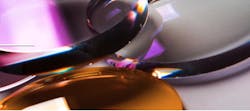Advances in Infrared and Laser Coatings
Infrared radiation traveling through the Earth’s atmosphere faces challenges due to atmospheric substances, resulting in atmospheric attenuation or extinction. This effect varies across different wavelengths, leading to the identification of key “atmospheric windows” in the infrared spectrum. Imaging in various infrared bands relies on distinct mechanisms, determining the spectral characteristics of thin films.
Infrared Coating Applications
- 3.7-4.8 μm Anti-reflective Coating: Designed for cryogenically cooled infrared detectors, operating in the 3.7-4.8 μm range. Materials include InAs, InSb, PbS, and PbSe, with Ge, mono crystalline silicon, ZnS, etc., as substrate materials.
- 8-12 μm Anti-reflective Coating: Tailored for cryogenically non-cooled infrared detectors used in night vision devices, infrared rangefinders, and identification equipment. Materials utilized are Germanium, mono crystalline silicon, and chalcogenide glass, among others.
- 4.26 μm Bandpass Filter: Applied in CO2 gas detection, ensuring high transmittance at 4.26μm and low transmittance elsewhere. Materials include sapphire, mono crystalline silicon, etc.
- 8-14 μm Filter: Essential for motion detection, intrusion sensors, and human imaging detection, with Germanium, monocrystalline silicon, etc., as key materials.
- 2-12 μm Filter: Designed for detectors using HgCdTe (Mercury Cadmium Telluride), covering a sensitive wavelength range from 2 to 12 micrometers (μm).
- 8-9.4 μm Bandpass Filter: Applied in specific component detection, featuring Germanium, monocrystalline silicon, etc., as essential materials.
Laser Coating Innovations
Thin films for high-power laser systems focus on spectral characteristics, resistance to laser-induced damage, and control of wavefront distortion. Metallic hafnium is employed for high-damage-threshold thin films.
-
Anti-reflective Coating:
- 248 nm: Applied to KrF Excimer Laser, featuring quartz materials. 1064 nm: Utilized in Nd:YAG laser systems, employing JGS1 materials.
-
High-Reflective Coating:
- Three-Band Reflective Mirror: For Nd:YAG laser systems, ensuring high reflectance for fundamental, second harmonic, and third harmonic light. Fourth Harmonic 266 nm Reflective Mirror: Addressing challenges posed by materials’ absorption at 266 nm wavelength.
-
Shortwave Pass Filter: Employing metallic hafnium for effective suppression of higher harmonics.
- Polarizer: Thin-film polarizers offer advantages over traditional components like Glan-Taylor prisms, ensuring low loss and large aperture. Non-Polarizer: Addressing polarization effects in inclined light incidence scenarios, enhancing system performance.
-
Bandpass Filter: Designed to allow specific wavelength ranges while blocking others.
- 365 nm Bandpass Filter: Widely used in various fields such as photolithography and UV curing. 222 nm Bandpass Filter: Featuring high sterilization rate against the novel coronavirus.
- Fiber Optic End Caps: Designed to withstand high laser power and surpassing military cleanliness standards, fiber optic end caps offer reliability and durability.
Do not hesitate to contact Shanghai Optics today. We’d be more than happy to discuss your projects and how best they can become a success.





